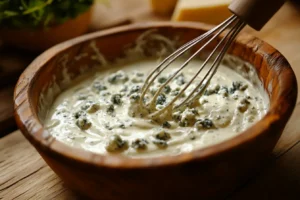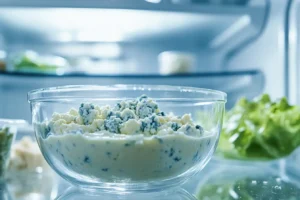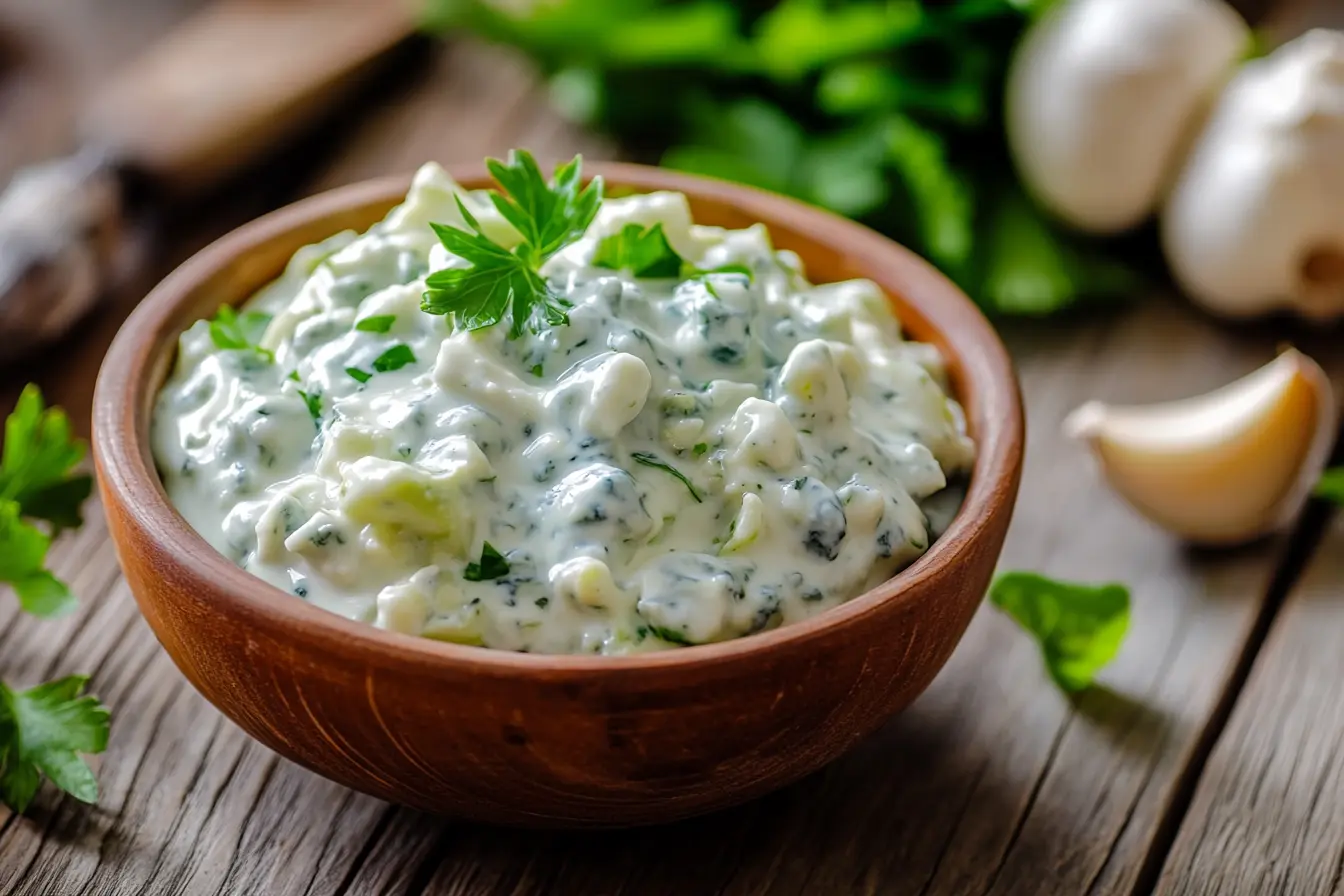Looking for a blue cheese salad dressing that’s rich, tangy, and irresistibly creamy? This is the one! Whether you’re dressing up a crisp wedge of iceberg lettuce or dipping your favorite veggies, this recipe is a game-changer. Bursting with bold flavor and velvety texture, it’s the ultimate complement to any salad or snack platter. And the best part? You can whip it up in minutes with just a handful of pantry staples. Forget store-bought—this homemade magic will elevate your meals to the next level!
Table of Contents
Ready to dive into the perfect blend of creamy, tangy, and cheesy goodness? Let’s get mixing!
Recipe Overview
This blue cheese salad dressing is a creamy masterpiece, balancing the sharp tang of blue cheese with the smoothness of mayonnaise and sour cream. Enhanced with a touch of garlic and a splash of vinegar, the flavor is bold yet harmonious. Whether drizzled over a classic salad, served as a dip, or even spread on a sandwich, it’s a versatile addition to your kitchen repertoire.
Made with simple, fresh ingredients, this dressing is gluten-free and can be easily adjusted to suit your taste preferences. The recipe packs a punch of flavor while delivering satisfying creaminess, all in under 10 minutes! Perfect for casual meals or sophisticated dinner parties, this dressing promises to impress every palate.
Looking for the nutritional breakdown? With its wholesome ingredients, you’ll find plenty of value in every serving. Check out the blue cheese dressing nutrition facts below for more!

Homemade Blue Cheese Salad Dressing: Creamy & Tangy
Ingredients
- 1/2 cup mayonnaise: The creamy base that ensures a smooth texture. Opt for full-fat mayo for richness or light mayo for fewer calories.
- 1/4 cup sour cream: Adds a tangy note and enhances the creaminess
- 1/4 cup crumbled blue cheese: The star of the show! Use a high-quality blue cheese for maximum flavor. Its bold, tangy profile is what makes this dressing unforgettable.
- 1 tablespoon white vinegar: Provides acidity to balance the creaminess. Apple cider vinegar or lemon juice can besubstituted
- 1 teaspoon garlic powder: Adds depth and a subtle savory kick.
- Salt and black pepper to taste: Essential for rounding out the flavors. Freshly cracked pepper works best.
- 2-3 tablespoons milk (optional): Adjusts the consistency if you prefer a thinnerdressing
Instructions
- Prepare the Base: In a medium-sized mixing bowl, combine 1/2 cup mayonnaise and 1/4 cup sour cream. Whisk together until the mixture is smooth and creamy. This forms the luxurious base of your dressing.

- Add the Star Ingredient: Gently fold in 1/4 cup crumbled blue cheese. Use a fork to lightly mash some of the crumbles, allowing the flavor to infuse throughout the dressing while keeping some chunks for texture.

- Incorporate the Tang: Add 1 tablespoon white vinegar to the mix. Stir well to evenly distribute the acidity, which balances the rich, creamy components.
- Flavor Boost: Sprinkle in 1 teaspoon garlic powder, then season with a pinch of salt and black pepper to taste. Adjust these according to your preferences. Whisk everything until the dressing is smooth, with visible flecks of blue cheese and spices.
- Adjust the Consistency:If you prefer a thinner dressing, gradually stir in 2-3 tablespoons milk,one tablespoon at a time, until you achieve your desired consistency. For a dip-like texture, skip this step

- Taste and Perfect: Take a small taste and tweak the seasoning. Add a bit more vinegar for tanginess, pepper for a spicy kick, or even extra blue cheese for a bolder profile.


Cooking Tips for a Perfect Blue Cheese Salad Dressing
- Choose the Right Blue Cheese:
Opt for high-quality blue cheese like Roquefort, Gorgonzola, or Stilton for a more pronounced flavor. If you prefer a milder taste, go for a Danish blue cheese. The quality of the cheese directly impacts the depth of flavor in your dressing. - Balance the Flavors:
If the blue cheese is too overpowering, add a teaspoon of honey or a splash of lemon juice to mellow the sharpness. For those who love bold flavors, consider increasing the amount of crumbled blue cheese. - Achieve the Perfect Consistency:
A thick dressing works well as a dip, while a thinner one is ideal for salads. Use milk to adjust the consistency gradually. For a professional touch, sieve the dressing for a silky finish. - Store It Right:
Keep your dressing in an airtight container in the fridge to maintain its freshness. Avoid storing it for more than five days as the blue cheese may lose its vibrant flavor. - Avoid Overmixing:
While mixing, don’t over-mash the blue cheese if you enjoy chunky bits in your dressing. This gives a delightful contrast in texture when served. - Enhance with Herbs:
For an aromatic twist, sprinkle in fresh or dried herbs like chives, parsley, or dill. These add a fresh and vibrant touch that pairs beautifully with the tangy blue cheese.
Common Mistakes to Avoid
- Over-seasoning: Don’t over-season before tasting. Blue cheese dressing can be salty on its own, and adding too much salt or seasoning can overpower the flavor.
- Using Low-Quality Ingredients: Avoid using low-quality mayonnaise. It can make the blue cheese salad dressing taste bland, lacking the creamy richness that makes it so delicious.
- Skipping the Chilling Step: Don’t skip the chilling step. Allowing the dressing to chill is crucial for developing the full flavor profile, making it more cohesive and flavorful.
Why Blue Cheese Salad Dressing is a Must-Have Dish
- A Flavor Explosion:
Few dressings pack as much flavor as blue cheese salad dressing. Its creamy texture and bold tangy notes make it an irresistible companion to salads, roasted vegetables, and even grilled meats. The combination of creamy mayonnaise, tangy vinegar, and savory blue cheese is a match made in culinary heaven. - Versatility at Its Best:
This dressing is more than just a salad topper. Use it as a dip for crunchy vegetables, a spread for sandwiches, or a sauce for wings. Its adaptable nature makes it a must-have in any kitchen, adding a gourmet touch to everyday dishes. - Quick and Easy to Make:
In just 10 minutes, you can whip up a batch of this homemade delight. Unlike store-bought versions, you have complete control over the ingredients, ensuring a fresher, healthier, and more delicious dressing. - Nutritional Benefits:
Packed with blue cheese dressing nutrition benefits, this recipe provides calcium for strong bones, probiotics for gut health, and essential fats that contribute to energy and satiety. While indulgent, it’s also a source of valuable nutrients when enjoyed in moderation. - A Gourmet Touch:
Homemade blue cheese salad dressing elevates any meal with a restaurant-quality flair. It’s the little detail that can transform a simple salad or snack into a luxurious dining experience. - Perfect for All Occasions:
Whether you’re hosting a dinner party, preparing a quick lunch, or indulging in a late-night snack, this dressing is the perfect addition. Its bold, creamy profile appeals to a wide range of tastes, making it a crowd-pleaser for all ages.

Variations and Customizations for Blue Cheese Salad Dressing
- Make It Lighter: Swap sour cream and mayo for Greek yogurt to reduce calories while keeping the creamy texture.
- Add a Zesty Kick: Add Dijon mustard or hot sauce for extra depth and heat.
- Herb-Infused Delight: Fresh herbs like parsley or chives bring a vibrant touch.
- Garlic Lovers’ Upgrade: Use roasted garlic for a sweet, mild flavor.
- Vegan-Friendly: Use plant-based mayo, sour cream, and vegan blue cheese for a dairy-free version.
- Extra Chunky: Double the blue cheese for a chunkier texture.
- Sweet and Tangy: Add honey or maple syrup to balance the tangy blue cheese.
- Spicy Blue Cheese: Spice it up with cayenne pepper or smoked paprika.
- Make It a Spread: Omit milk to thicken it for a sandwich spread.
- Low-Sodium: Use reduced-sodium blue cheese to create a heart-healthy version.
Nutritional Information for Blue Cheese Salad Dressing
A 2-tablespoon serving of homemade blue cheese salad dressing contains:
- Calories: 120–150, depending on ingredient choices.
- Fat: 13g, providing healthy fats from mayo and cheese.
- Protein: 2g, from the cheese.
- Carbohydrates: 1–2g, low-carb and keto-friendly.
- Micronutrients:
- Calcium: 10–15% of your daily needs.
- Vitamin A: Supports vision and immunity.
- Sodium: 250–300mg, can be reduced with low-sodium ingredients.
- Probiotics: If made with live-culture sour cream or yogurt.
Tips for Health-Conscious Enjoyment:
- For fewer blue cheese dressing calories, swap full-fat mayo with light or avocado-based alternatives.
- Adjust portion sizes to fit your dietary goals—1 tablespoon works well for a hint of flavor without overindulging.
- Enhance the nutrient profile by pairing the dressing with nutrient-rich salads, such as those featuring leafy greens, nuts, and fruits.
Serving Ideas for Blue Cheese Salad Dressing
This blue cheese salad dressing is a versatile addition to many dishes, elevating both simple meals and gourmet spreads. Here are some creative ways to serve it:
- Classic Salad Topper:
The most obvious choice! Drizzle this creamy dressing over a fresh, crisp salad. It pairs wonderfully with greens like romaine, arugula, or iceberg lettuce. Add some crunchy veggies like carrots, celery, and cucumbers, and you’ve got a perfect salad ready to go. - Buffalo Wings Dip:
Blue cheese dressing and buffalo wings are a match made in heaven. Use it as a dip for your wings or drizzle it over the top to add a creamy contrast to the spicy heat. It’s the perfect balance for game day or a casual gathering. - Veggie Dip:
Serve this dressing as a dip for fresh veggies like baby carrots, celery, bell peppers, or cucumber slices. It’s a great way to make healthy snacking more flavorful and fun! - Sandwich Spread:
Use this creamy blue cheese dressing as a spread for sandwiches and wraps. Whether it’s a classic club sandwich or a veggie wrap, this dressing adds richness and a sharp flavor that complements a variety of fillings. - Grilled Steak or Chicken:
For a more indulgent meal, drizzle it over grilled steak or chicken. The rich dressing adds a creamy, tangy note that pairs beautifully with the smoky, savory flavors of grilled meats. - Potato Salad Topping:
Use this dressing as a twist on traditional potato salad dressing. It gives the potatoes a rich, creamy flavor that elevates the entire dish. You can also mix in some crumbled bacon or fresh herbs for added texture and taste. - Crispy Fries Dip:
Blue cheese dressing makes an excellent dip for crispy fries or sweet potato fries. Whether you’re enjoying a casual meal or entertaining guests, this dip will add a gourmet touch to your fries. - Roasted Vegetables:
Roast some seasonal vegetables—like Brussels sprouts, cauliflower, or carrots—and drizzle with this dressing for a creamy, tangy finishing touch. It’s a great way to add flavor and richness to a vegetable side dish. - Wedge Salad:
Turn a simple wedge of iceberg lettuce into a showstopper by topping it with blue cheese salad dressing. Add crumbled bacon, diced tomatoes, and a sprinkle of chives for an easy yet impressive side dish. - As a Pizza Drizzle:
For something a bit unconventional, drizzle this blue cheese dressing over a freshly baked pizza, especially a buffalo chicken or pear and walnut pizza. It creates a delightful contrast of flavors and adds creaminess to each bite.
Fun Facts About Blue Cheese Salad Dressing
- The Origins of Blue Cheese
Blue cheese dates back to the Roman Empire, and its distinct flavor has been loved for centuries. The tradition of creating blue cheese dressing began in the United States in the early 20th century, with the first popular recipe emerging in the 1920s. It quickly became a favorite dressing for salads, dips, and more! - Blue Cheese’s Unique Mold
The distinctive “blue” streaks in blue cheese are caused by the mold Penicillium roqueforti. This mold is introduced to the cheese during production, giving it its signature flavor and appearance. Blue cheese has been admired for its bold and tangy flavor, making it a standout in many dishes—including this creamy dressing! - The First Blue Cheese Dressing Recipe
The origins of blue cheese salad dressing can be traced back to the creation of the famous “Wedge Salad” in the 1920s, which was typically topped with a rich blue cheese dressing. The dressing gained widespread popularity in the U.S. in the 1970s after being commercialized by brands like Marie’s and Hidden Valley, who brought this rich, creamy dressing to home kitchens nationwide. - Pairing with Buffalo Wings
It’s no surprise that blue cheese dressing is most famously paired with buffalo wings. The tangy, creamy dressing provides a perfect counterbalance to the heat from the spicy buffalo sauce. This combination is now considered a classic in American comfort food. - The Popularity of Blue Cheese in Salads
While blue cheese dressing has always been popular in wedge salads, its popularity exploded in the 1980s, when it was incorporated into various salads at restaurants. From Cobb salads to mixed greens, blue cheese dressing became a go-to topping for many salad varieties. - A Bold Flavor for Bold Food Lovers
Blue cheese’s intense flavor isn’t for everyone. People either love it or hate it. Interestingly, it is a source of many health benefits—such as calcium and probiotics—but it’s the flavor that truly defines it. For fans of bold, tangy flavors, blue cheese dressing is a beloved staple. - The Creamy vs. Chunky Debate
When it comes to blue cheese dressing, there’s a long-standing debate: creamy or chunky? Some prefer a smooth, velvety dressing, while others love the texture and tanginess of a chunkier version. No matter the preference, the bold flavor of blue cheese remains the star! - A Go-To for More Than Just Salads
Though originally designed for salads, blue cheese dressing has found its place in many other dishes—like as a topping for burgers, a dip for fries, or even a drizzle on pizza. Its versatility makes it a beloved ingredient for any occasion. - A Secret Ingredient in Some Classic Dips
Many classic dips, such as ranch dip and buffalo chicken dip, get their extra creamy flavor from a splash of blue cheese dressing. It adds an extra layer of flavor complexity that makes these dips even more irresistible. - Blue Cheese vs. Roquefort
While all blue cheese varieties have a similar base, Roquefort is one of the oldest and most iconic types of blue cheese. It originates from France and has a particularly sharp, tangy flavor that works beautifully in blue cheese dressing.
Why You’ll Love This Recipe
This homemade blue cheese salad dressing is everything you’ve been craving—bold, creamy, and incredibly flavorful. The rich combination of mayonnaise, sour cream, and tangy blue cheese creates a dressing that enhances any dish. Whether drizzled on a salad, used as a dip, or spread on sandwiches, it brings a gourmet touch to the table.
Not only is it quick and easy to make, but it’s also highly customizable. Adjust the tanginess or add extra cheese to suit your taste. Plus, you can control the ingredients for a healthier version, making it a lighter option compared to store-bought dressings.
Its versatility goes beyond salads, pairing perfectly with veggies, grilled meats, and even pizza. With its bold flavor and creamy texture, this blue cheese dressing will quickly become a staple in your kitchen. Once you try it, you’ll never want to go back to the store-bought version!
FAQ About blue cheese dressing
How long will blue cheese dressing last in the fridge?
Homemade blue cheese salad dressing can last in the fridge for up to 1 week when stored in an airtight container. Always make sure to check for any signs of spoilage, such as changes in texture or odor, before using it.
Why does my homemade blue cheese dressing get watery?
If your homemade blue cheese dressing becomes watery, it’s often due to excess moisture in the ingredients (like sour cream or mayo) or from the blue cheese itself. To fix this, try adding more cheese to thicken it or reduce the amount of liquid (milk or buttermilk) you’re using. Mixing it well and storing it in the fridge can also help prevent it from separating.
Is blue cheese salad dressing healthy for you?
Blue cheese dressing can be part of a healthy diet when consumed in moderation. It’s rich in fats, so it’s calorie-dense, but it also provides calcium, protein, and probiotics if made with yogurt or sour cream. For a lighter version, use low-fat alternatives.
Can I eat old blue cheese dressing?
You should not eat old blue cheese dressing if it has been stored for longer than 1 week or if it shows signs of spoilage like an off smell, mold growth, or separation. Always check the dressing carefully before consuming to ensure it’s still safe to eat.

Conclusion
Ready to dive into the world of creamy, tangy bliss? This blue cheese salad dressing will quickly become your go-to favorite for salads, dips, and more! Whether you’re enjoying it on a fresh green salad, drizzling it over crispy wings, or pairing it with a hearty burger, it adds the perfect punch of flavor to any dish.
And remember, making this dressing at home gives you full control over the ingredients, allowing you to customize it to your liking and dietary needs. So, why not whip up a batch today and add a little extra indulgence to your meals?
Go ahead, treat yourself to a drizzle (or two) of this irresistible dressing! Who’s going to judge if you finish the whole batch yourself? Enjoy!

